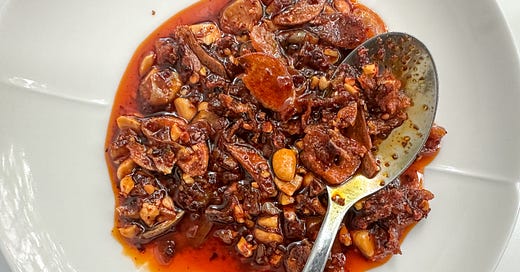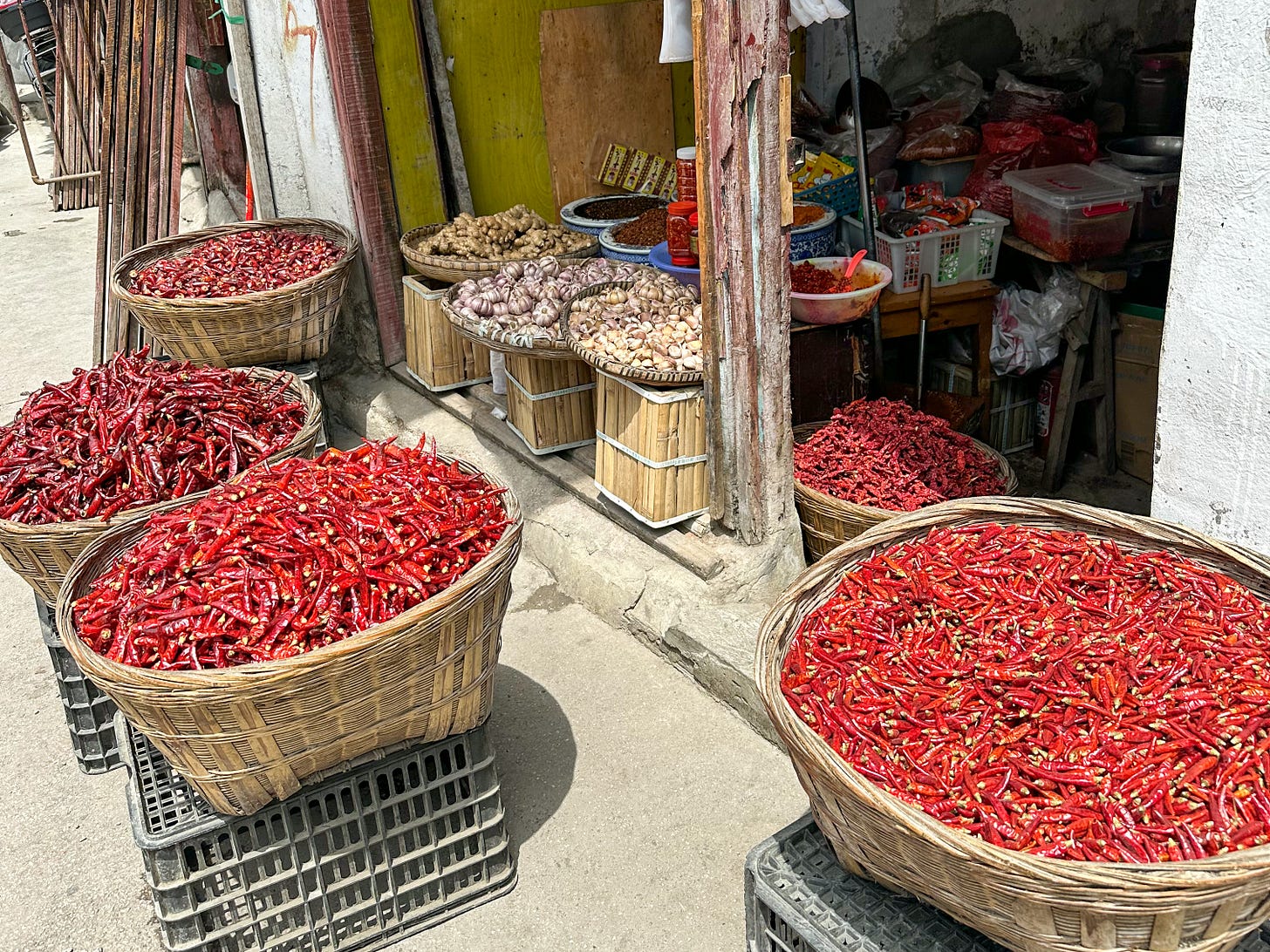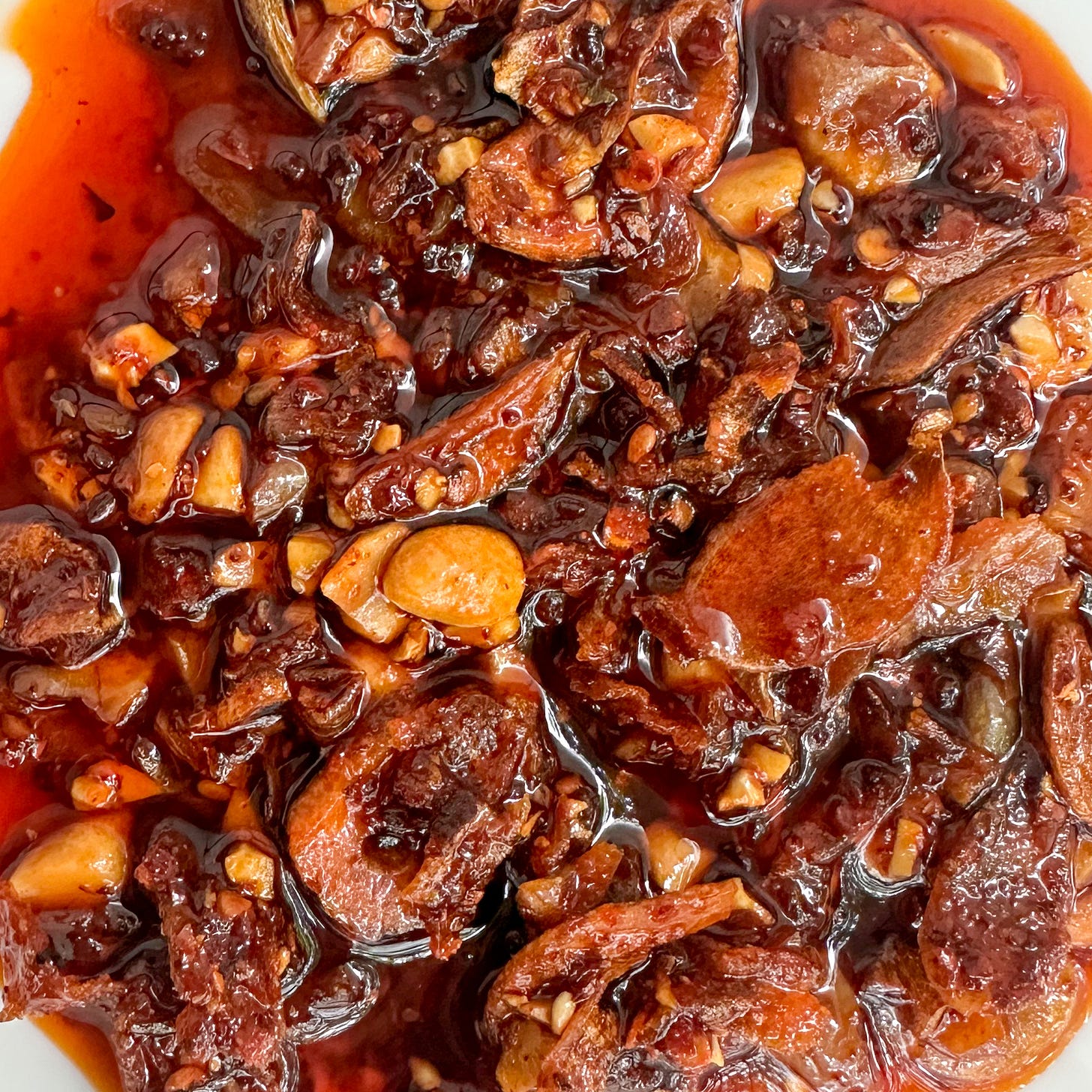Hi! This week is a long read, a nerdy deep-dive into food history. If you can’t wait to make home version of chili crisp, find the recipe at the bottom, or watch the video here!
The discussion about chili crisp, which started from Momofuku’s trademark controversy, inevitably got me thinking about this condiment. It’s something that I’m ultimately familiar with, yet always enchanted by how it’s revered and talked about as a hype new thing.
Many pointed to Lao Gan Ma as the origin, which was also the most well-known commercial chili crisp brand and my first taste in the early 2000s. But Lao Gan Ma probably didn’t invent it. What's before that?
The book History of Chili Pepper in China 1 provided insight. Chili pepper reached China through coastal trading in the late 16th century, a bit later than its arrival in Japan in the mid-16th century. This introduction was not a singular event but rather a gradual process spanning the 15th and 16th centuries2. Initially, chili peppers were regarded merely as ornamental plants. However, their adoption in Chinese medicine eventually led to small-scale local farming in the Yangtze River region.
It wasn’t until the 18th century that chili was consumed as food3. Guizhou was the first region to adopt chilis in their cuisine, as an effort to substitute salt. The impoverished area was struggling with population growth, inconvenient transportation, and shortages of grain and salt. So chili was used to make condiments to eat with meals, first among Miao (Hmong) and Tujia minorities. Another salt substitute found in this region is sour ingredients, which, together with chili, now constitute the prevailing flavor profile of the area.
Chili's fiery flavor was documented in local chronicles and first appeared in recipes in the 1790 book Tiao Ding Ji4, featuring chili flakes, oil, and sauce. In Guizhou, chili condiments take various forms, including fermented, toasted, and fried varieties. Crispy chili oil (油辣椒) and ciba chili paste (糍粑辣椒) later influenced Sichuan cuisine, while other chili condiments like dipping seasoning (蘸水) and marinated chopped chilis (腌辣椒) made their way to Yunnan and Hunan. Guizhou has witnessed chili peppers evolve from foreign ingredients to integral staples in Chinese cuisine. During my visit to Guizhou last April, I ate through a plethora of dishes with chilis, including crispy deep-fried chili snacks found on street corners for casual snacking.
By the early 20th century, chili had been localized and became one of the most important condiments in the cuisines of almost the entire southwestern region, as well as expanded to northern China through Shaanxi (remember those chili flakes sizzled in oil over noodles?).
For centuries, spicy food has been linked to poverty and lower social classes. Chili peppers, being easy to grow and economically viable, thrive in the southern mountain regions. As feudal China ended, so did the class connotations associated with spicy cuisine. The economic growth and urbanization brought a surge of migrant workers to metropolitan areas, where spicy food, like hot pot, became an integral part of the affordable lifestyle and social gatherings. Over the past three decades, spicy food has undergone gentrification, emerging as a mainstream culinary trend in China, extending from Sichuan and Hunan restaurants to popular snacks like La Tiao (辣条).
Lao Gan Ma, founded in the late 1990s by female entrepreneur Tao Huabi in Guizhou's capital city, swiftly rose to nationwide fame as the foremost brand of chili oil condiment in the early 2000s. Its iconic crispy chili oil (香辣脆油辣椒), revered as the OG chili crisp, along with other variations embodies the rich tradition of Guizhou cuisine. According to Chinese Cooking Demystified, this mass-produced condiment is a combination of the crispy chili snack and chili oil. In China, chili crisps and sauces like Lao Gan Ma are made for topping with rice (xia fan, 下饭) while chili oil, or the Sichuan-style red oil is used for cooking. Store-bought chili condiments are embraced by the younger generation and adept cooks will still make their own chili oil, however, the distinction in English-speaking discourse are becoming blurred.
My first bite of chili crisp was at boarding school at the age of eight. A group of picky eaters brought Lao Gan Ma with our name tags to eat with canteen food. Over the years, I've sampled nearly every flavor of LGM. It was also one of the first pantry items I bought to set up my kitchen when I moved to Berlin 9 years ago. Before all the cool hip brands hit the social media, LGM was the only option. It not only inspired the name of this blog but also, to this day stayed very close to my cooking and identity. A condiment thats holds the weight of finding comfort in a completely new and strange place; it should be celebrated, not restricted.
The recipe
This chili crisp recipe is an adaptation of my Sichuan chili oil, added with garlic, store-bought crunchy ingredients and seasoning. For detailed explanation on the choice of chili, check the chili oil article!
Ingredients
makes 4 small jars
500g rapeseed oil, or neutral vegetable oil
100g chili flakes
20g sesame seeds
10 cloves of garlic
40g roasted, salted peanuts
20g fried onions (shallots)
1 tbsp salt
1 tbsp sugar
1 tsp MSG (optional)
Aromatics and Spices: Sichuan pepper, cinnamon stick, bay leaf, tso kuo, red onion
Instructions:
Thinly slice garlic, red onion, and ginger. Roughly chop the fried fava beans and peanuts, then add to a bowl with fried onions.
Mix chili flakes with sesame seeds in a big enough, heat-proof bowl, then add a tbsp of oil to mix well.
Heat oil to about 120ºC/250ºF, then fry garlic slices until golden brown, remove and let drain on a paper towel. Then add aromatics, fry for about 10-15 min, remove and discard.
Heat the oil to 180ºC/360ºF, and pour over the chili flakes in batches when it cools down to 140ºC/280ºF and 100ºC/230ºF. After the last pour, add all the crunchy bites, and mix to combine. Let it cool down before adding to jars and containers.
A History of Chili Pepper in China is a book written by Cao Yu in Chinese (《中国食辣史》,曹雨), you can find a translated article by the same author here. I also referenced another book with a similar theme called The Chile Pepper in China: A Cultural Biography by Brian R. Dott ( I read the Chinese version《吃辣:辣椒的中国史》, 达白安).
Different sources of chili peppers include from the coast through Southeast Asia, from northeastern through North Korea, or from Taiwan through the Dutch colonization.
Cao Yu believes that the first written record of eating chili is in 1721 from a local archive in Guizhou. Da Baian claimed that it appeared earlier in a book about food and herbs published in 1621 (《食物本草》)
Tiao Ding Ji (《调鼎集》) is a cookbook from Qing Dynasty, which includes a recipe for frying whole chilis in oil: “大椒油麻油;整大椒入麻油炸透;去椒存油,听用”







